Spilostethus pandurus
Spilostethus pandurus is a species of "seed bugs" belonging to the family Lygaeidae, subfamily Lygaeinae.
| Spilostethus pandurus | |
|---|---|
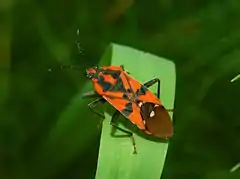 | |
| Spilostethus pandurus, upperside | |
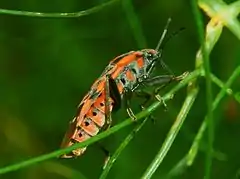 | |
| Side view | |
| Scientific classification | |
| Kingdom: | |
| Phylum: | |
| Class: | |
| Order: | |
| Suborder: | |
| Infraorder: | |
| Superfamily: | |
| Family: | |
| Subfamily: | |
| Genus: | |
| Species: | S. pandurus |
| Binomial name | |
| Spilostethus pandurus (Scopoli, 1763) | |
| Synonyms | |
| |
Etymology
The species was described in 1763 by Scopoli in his "Entomologica carniolica" with locus typicus from the area around Ljubljana. Scopoli does not mention the etymology of the species name but may have named it for the Panduri infantry unit of the Habsburg Monarchy.
Subspecies
Subspecies include:[1]
- S. pandurus subsp. pandurus (Scopoli, 1763): Native to Albania, Austria, Bulgaria, Corsica, Crete, Crimea, Cyprus, Czech Republic, France, Germany, Greece, Hungary, Italy, Portugal, Russia, Sardinia, Spain, Switzerland, Yugoslavia, Algeria, Egypt, Lybia, Morocco, Nigeria, Senegal, Sierra Leone, Slovakia, Sudan, Kenya, Arabia, Iran, Iraq, Israel and India.
- S. pandurus subsp. militaris (Fabricius, 1775): Native to Albania, Austria, Belgium, Bulgaria, Corsica, Crete, Cyprus, Czech Republic, France, Germany, Greece, Italy, Majorca, Malta, Portugal, Romania, Russia, Sardinia, Sicily, Slovakia, Spain, Switzerland, Yugoslavia, Algeria, Egypt, Ethiopia, Libya, Morocco, Mozambique, Sahara, Senegal and Sierra Leone.
- S. pandurus subsp. elegans (Wolff, 1802): Native to Central and Southern Africa, Canary Islands, India and Israel.
- S. pandurus subsp. asiaticus (Kolenati, F.A., 1845): Native to Madagascar.
- S. pandurus subsp. tetricus (Horvath, G., 1909): Native to the Canary and Madeira islands.
Distribution
This species can be found in the Euro-mediterranean-Turaniaan Region, with a more southern distribution than Spilostethus saxatilis.
It is present in Albania, Austria, Bulgaria, Croatia, Cyprus, Czech Republic, France, Germany, Greece, Hungary, Italy, Israel, Malta, Portugal, Romania, Russia, Serbia, Slovakia, Slovenia, Spain, Switzerland, Turkey, in the Afrotropical realm.[2] and in the southern Asia to India and China.
Description
Spilostethus pandurus can reach a length of 13–15 millimetres (0.51–0.59 in). Body shows a red-black coloration with a white spot in the center of the membrane.
Two wavy, broad, black, longitudinal stripes run from the front to the rear edge of the pronotum. Scutellum is black, sometimes with a small red spot at the end.[3][4]
The nymphs are bright red, with black markings.
These bugs have two dorsolateral prothoracic glands capable of secreting substances repugnant to predators.
Biology
These polyphagous bugs feed on flowers and seeds of many plants. They preferentially feed on the plants of the family Apocynaceae. In Europe, they are present on various toxic plants such as jimsonweed (Datura stramonium) and oleander (Nerium oleander).
They can cause serious damage to the crops of Sesamum indicum (Pedaliaceae) and to Calotropis gigantea and Calotropis procera (Apocynaceae).
It can also attack sorghum crops (Sorghum bicolor), Eleusine coracana, Pennisetum americanum, Phaseolus mungo, Arachis hypogaea, Lycopersicum esculentum, tobacco, sunflowers etc.[5]
Gallery
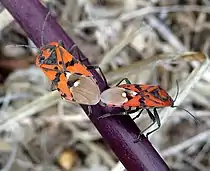 Mating
Mating.JPG.webp) Nymph
Nymph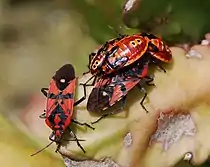 Adult and nymphs
Adult and nymphs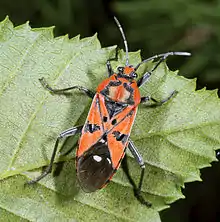 Female
Female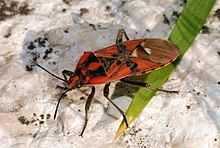 Male
Male
References
| Wikispecies has information related to Spilostethus pandurus. |
| Wikimedia Commons has media related to Spilostethus pandurus. |
- Fauna europaea
- Keys at Les insectes (in French)
- Natura Mediterraneo (in Italian)
- Carl Walter Schaefer, Antonio Ricardo Panizzi, Heteroptera of economic importance, CRC Press, 2000
External links
- Le Monde des Insectes (in French)
- INPN - Inventaire National du Patrimoine Naturel (in French)
- Les Insectes (in French)